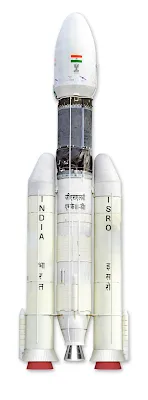India’s space program has come a long way since its inception in the early 1960s. Over the years, the Indian Space Research Organization (ISRO) has achieved several significant milestones and become a crucial player in the global space industry. One of the most significant developments in India’s space program was the launch of the Geosynchronous Satellite Launch Vehicle Mark III (GSLV Mk III) rocket, also known as the LVM3, in 2017.
The GSLV Mk III is a game-changer for India’s space program, as it enables the country to launch heavy satellites into orbit and reduces its dependence on foreign launch vehicles. This article discusses the GSLV Mk III rocket’s features, its development process, and its implications for India’s space program.
Features of GSLV Mk III Rocket
.jpg) |
| Features of GSLV Mk III Rocket |
The GSLV Mk III rocket is a three-stage rocket with a total height of 43.43 meters and a lift-off weight of 640 tons. The first stage of the rocket is powered by two S200 solid rocket boosters, each with a diameter of 3.2 meters and a length of 25 meters. The S200 boosters are the largest solid rocket boosters ever used in an Indian rocket, and they provide a thrust of 5000 kN each.
The second stage of the rocket is powered by a Vikas engine, which is the same engine used in the second stage of the Polar Satellite Launch Vehicle (PSLV). The Vikas engine provides a thrust of 800 kN and has a specific impulse of 293 seconds. The third stage of the rocket is powered by a cryogenic engine, which uses liquid hydrogen and liquid oxygen as propellants. The cryogenic engine provides a thrust of 20 kN and has a specific impulse of 443 seconds.
The GSLV Mk III rocket has a payload capacity of 8,000 kg to Geosynchronous Transfer Orbit (GTO) and 10,000 kg to Low Earth Orbit (LEO). This payload capacity is more than double that of the GSLV Mk II rocket, which had a payload capacity of 2,200 kg to GTO and 5,000 kg to LEO. With this increased payload capacity, India can launch heavier satellites into space and reduce its dependence on foreign launch vehicles.
Development Process of GSLV Mk III Rocket
The development of the GSLV Mk III rocket began in the 1990s, with the aim of developing a launch vehicle capable of carrying heavier payloads into orbit. The initial design of the rocket was based on the GSLV Mk II rocket, which had a limited payload capacity. The GSLV Mk III rocket was designed to use both solid and liquid propellants to provide the necessary thrust to launch heavier payloads.
The development process of the GSLV Mk III rocket faced several technical challenges, including the development of the cryogenic engine. The cryogenic engine uses liquid hydrogen and liquid oxygen as propellants, which requires extremely low temperatures to maintain their liquid state. The engine also requires complex fuel management systems to ensure the propellants are delivered at the right flow rate and pressure.
ISRO faced several setbacks during the development of the GSLV Mk III rocket. In 2010, the first test flight of the rocket was unsuccessful due to a malfunction in the control system of the S200 solid rocket boosters. In 2017, the second test flight of the rocket was successful, and it was used to launch the GSAT-19 satellite into orbit.
Implications for India’s Space Program
 |
| ISRO logo |
The GSLV Mk III rocket is a game-changer for India’s space program, as it enables the country to launch heavy satellites into orbit and reduces its dependence on foreign launch vehicles. India has historically relied on foreign launch vehicles to launch its

No comments:
Post a Comment
Thanks